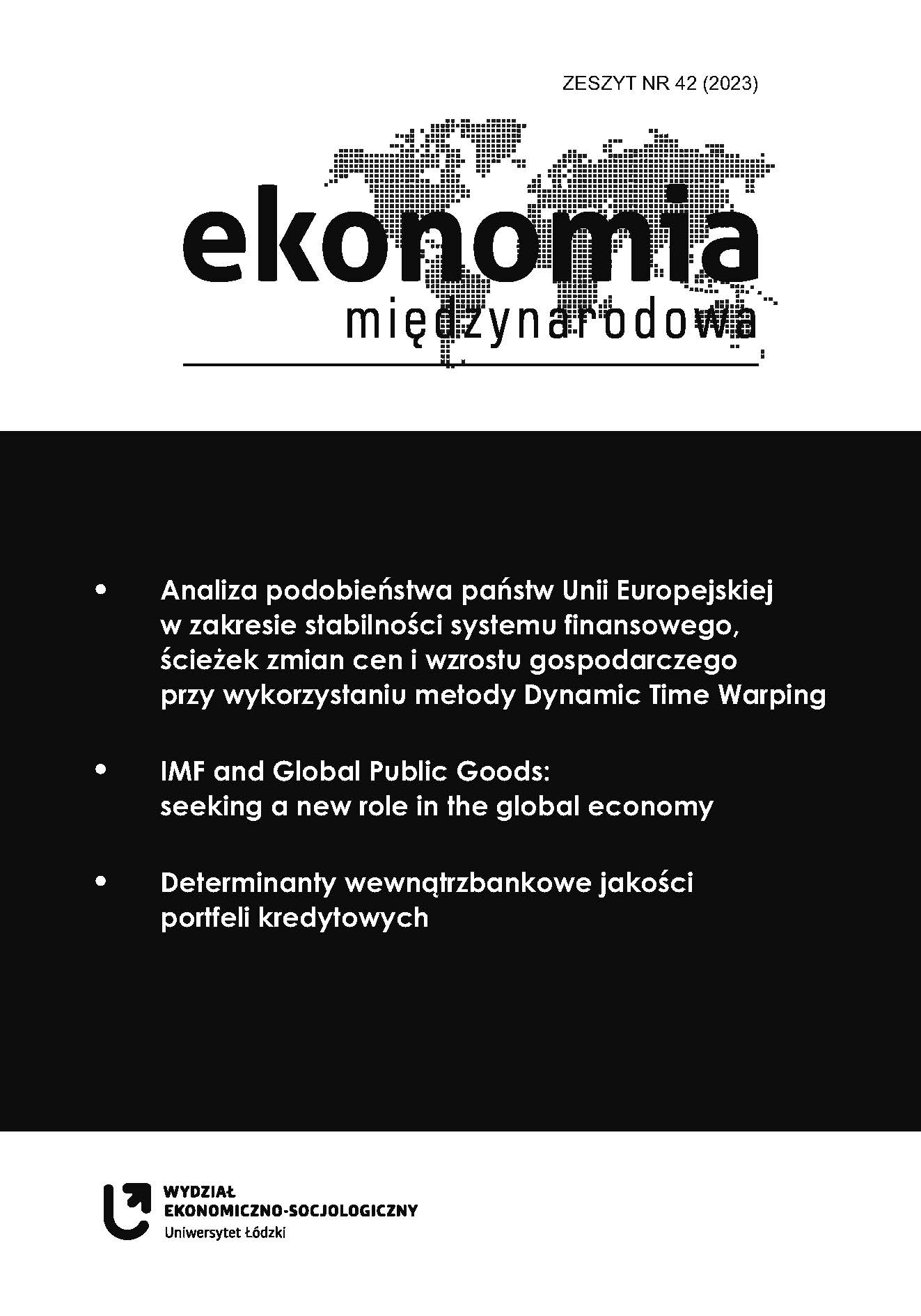The similarity analysis of the EU countries in terms of financial system stability, price changes and economic growth using Dynamic Time Warping
DOI:
https://doi.org/10.18778/2082-4440.42.01Keywords:
financial system, financial system stability, economic growth, Dynamic Time Warping, European UnionAbstract
The article attempts to answer how similar the European Union (EU) countries are regarding the financial system’s behavior, especially its stability. We verify whether changes in the stability of the financial sector are analogous to changes in inflation rates as well as real output and income dynamics. Based on similarities in the financial sector stability and the real economy, we group EU countries into clusters. An element of novelty is the use of the Dynamic Time Warping (DTW) method. It is an innovative method for time series analysis, which has been relatively rarely applied to macroeconomic variables in the economic literature. The analysis covers 27 EU countries and the 2010–2023 period. We use five variables: non-performing loans, banks’ capital adequacy ratio, inflation rate, GDP growth and industrial production index. The results show that countries with the same model of capitalism (Continental, Nordic, Mediterranean, Liberal, and Patchwork) are relatively often highly similar to each other. This means that the institutional environment in a given country, including the model of capitalism, explains to some extent the similarity of time paths of financial and macroeconomic variables in many EU countries.
References
Alińska A., Wasiak K. (red.) (2017), Mechanizmy stabilności systemu finansowego, CH Beck, Warszawa.
Google Scholar
Amable B. (2003), The Diversity of Modern Capitalism, Oxford University Press, Oxford.
Google Scholar
DOI: https://doi.org/10.1093/019926113X.001.0001
Bai L., Cui L., Zhang Z., Xu L., Wang Y., Hancock E.R. (2023), Entropic Dynamic Time Warping Kernels for Co-Evolving Financial Time Series Analysis, „IEEE Transactions on Neural Networks and Learning Systems”, 34(4): 1808–1822.
Google Scholar
DOI: https://doi.org/10.1109/TNNLS.2020.3006738
Bernardelli M. (2023), Monitorowanie działalności gospodarczej. Gospodarka po pandemii Covid-19, monografia pokonferencyjna z okazji 50-lecia Instytutu Rozwoju Gospodarczego SGH, Oficyna Wydawnicza SGH, Warszawa (red. M. Radzikowski) (w druku).
Google Scholar
Bernardelli M., Próchniak M. (2023), Wykorzystanie Dynamic Time Warping do analizy polityki pieniężnej, sektora finansowego i wzrostu gospodarczego Polski i wybranych innych krajów Europy Środkowo-Wschodniej, „Studia i Prace Kolegium Zarządzania i Finansów Szkoły Głównej Handlowej w Warszawie”, (191): 101–122; https://doi.org/10.33119/SIP.2023.191.7
Google Scholar
DOI: https://doi.org/10.33119/SIP.2023.191.7
D’Urso P., De Giovanni L., Massari R. (2021), Trimmed fuzzy clustering of financial time series based on dynamic time warping, „Annals of Operations Research”, 299: 1379–1395.
Google Scholar
DOI: https://doi.org/10.1007/s10479-019-03284-1
Denkowska A., Wanat S. (2021), Dynamic Time Warping Algorithm in Modeling Systemic Risk in the European Insurance Sector, „Entropy”, 23(8): 1022.
Google Scholar
DOI: https://doi.org/10.3390/e23081022
Franses P.H., Wiemann T. (2020), Intertemporal Similarity of Economic Time Series: An Application of Dynamic Time Warping, „Computational Economics”, 56: 59–75.
Google Scholar
DOI: https://doi.org/10.1007/s10614-020-09986-0
Gassouma M.S., Benhamed A., El Montasser G. (2023), Investigating similarities between Islamic and conventional banks in GCC countries: a dynamic time warping approach, „International Journal of Islamic and Middle Eastern Finance and Management”, 16(1): 103–129.
Google Scholar
DOI: https://doi.org/10.1108/IMEFM-11-2020-0565
Hall P., Soskice D. (2001), Varieties of Capitalism. The Institutional Foundations of Comparative Advantage, Oxford University Press, Oxford.
Google Scholar
DOI: https://doi.org/10.1093/0199247757.001.0001
Próchniak M., Czerniak A., Gardawski J., Horbaczewska B., Karbowski A., Maszczyk P., Rapacki R., Towalski R. (2019), Kapitalizm patchworkowy w Polsce i krajach Europy Środkowo-Wschodniej, Polskie Wydawnictwo Ekonomiczne, Warszawa.
Google Scholar
Raihan T. (2017), Predicting US Recessions: A Dynamic Time Warping Exercise in Economics, SSRN Working Paper Nr 3047649.
Google Scholar
DOI: https://doi.org/10.2139/ssrn.3047649
Rapacki R. (red.) (2019), Diversity of Patchwork Capitalism in Central and Eastern Europe, Routledge, London.
Google Scholar
DOI: https://doi.org/10.4324/9780429056901
Sakoe H., Chiba S. (1978), Dynamic programming algorithm optimisation for spoken word recognition, „IEEE Transactions on Acoustics, Speech, and Signal Processing”, 26(1): 43–49.
Google Scholar
DOI: https://doi.org/10.1109/TASSP.1978.1163055
Vintsyuk T. (1968), Speech discrimination by dynamic programming, „Cybernetics”, 4(1): 81–88.
Google Scholar
DOI: https://doi.org/10.1007/BF01074755
Downloads
Published
Versions
- 2024-05-27 (2)
- 2023-06-30 (1)
How to Cite
Issue
Section
License

This work is licensed under a Creative Commons Attribution-NonCommercial-NoDerivatives 4.0 International License.
Funding data
-
Narodowe Centrum Nauki
Grant numbers 2018/31/B/HS4/00164









